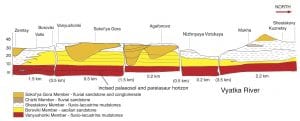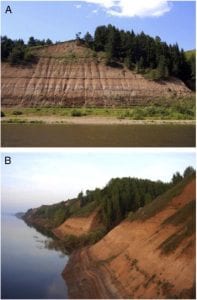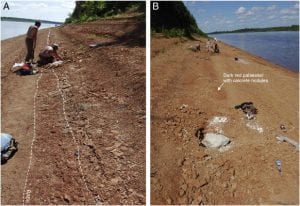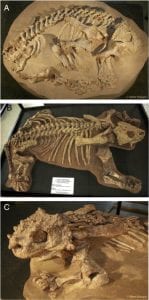Kotel’nich is especially famous as a major source of fossil tetrapods, most notably the pareiasaur Deltavjatia, known from dozens of near-perfect skeletons preserved in the most extraordinary fashion in hollows formed on top of a consolidated palaeosol horizon. The first finds were reported in the 1890s, and since 1950, many dozens of fine skeletons have been excavated
Geology
The main section at Kotel’nich lies on the west bank of the Vyatka River, and it shows five members, two yielding fossil tetrapods – the Vanyushonki Member at the base, and the Sokol’ya Gora Member at the top.
 Fig. 1. Sketch section along the western bank of the Vyatka River between Zemtsy in the south and Kuznetsy in the north, showing the arrangement of the main stratigraphical units. The Vanyushonki Member is predominantly fluvio-lacustrine mudstone, which is overlain by the Boroviki Member, a flat-based, lensoid, predominantly aeolian sandbody, and the Shestakovo Member, a further series of fluvio-lacustrine mudstones. These are followed by the channel forms of the Chizhi and Sokol’ya Gora members, which comprise coarse-grained fluvial sandstones and intraclast conglomerates in lenticular bodies spectacularly incised into the older units. Vertebrates are primarily found in mudstones toward the base of the cliff in the Vanyusonki Member, in the marked paleosol horizon. Distances (km) in brackets indicate breaks in exposure that are not shown in the diagram. Figure is adapted from Tverdokhlebov (2009).
Fig. 1. Sketch section along the western bank of the Vyatka River between Zemtsy in the south and Kuznetsy in the north, showing the arrangement of the main stratigraphical units. The Vanyushonki Member is predominantly fluvio-lacustrine mudstone, which is overlain by the Boroviki Member, a flat-based, lensoid, predominantly aeolian sandbody, and the Shestakovo Member, a further series of fluvio-lacustrine mudstones. These are followed by the channel forms of the Chizhi and Sokol’ya Gora members, which comprise coarse-grained fluvial sandstones and intraclast conglomerates in lenticular bodies spectacularly incised into the older units. Vertebrates are primarily found in mudstones toward the base of the cliff in the Vanyusonki Member, in the marked paleosol horizon. Distances (km) in brackets indicate breaks in exposure that are not shown in the diagram. Figure is adapted from Tverdokhlebov (2009).
Upper Permian red beds, comprising mudstones, siltstones, marls, sandstones, and conglomerates, are exposed on the right-hand (western) bank of the Vyatka River at, and for some 24 km south of, the town of Kotel’nich, from Port Kotel’nich (58.29136N, 48.33060E) to Zemtsy (58.13931N, 48.36058E). Here, the Vyatka River cuts westwards into an elevated escarpment of Permian rocks creating a discontinuous series of large outcrops in the generally flat-lying Permian succession (Fig. 1), ranging up to 40 m high at Agafonovo (58.18637N, 48.32864E). The spectacular red, yellow, and brown colours of the near horizontally-bedded clastic sediments (Fig. 2) have been noted many times by previous authors.
 Fig. 2. Two views of the Kotel’nich tetrapod localities. (A) The right (west) bank of the Vyatka River, 15 km south of Kotel’nich town, near Boroviki village, at about 58.16092N, 48.34928E, showing a typical section through the red sediments of the Vanyushonki Member on the foreshore and in the lower one-third of the cliff, a thin strip of the overlying Boroviki Member sandstones, and the red sediments of the Shestakovy Member above. (B) The steep-sided cliff at Port Kotel’nich (58.29136, 48.32449), close to the ‘dicynodont quarry’, excavated in the early 1990s. Photographs by Al’bert Yu. Khlyupin.
Fig. 2. Two views of the Kotel’nich tetrapod localities. (A) The right (west) bank of the Vyatka River, 15 km south of Kotel’nich town, near Boroviki village, at about 58.16092N, 48.34928E, showing a typical section through the red sediments of the Vanyushonki Member on the foreshore and in the lower one-third of the cliff, a thin strip of the overlying Boroviki Member sandstones, and the red sediments of the Shestakovy Member above. (B) The steep-sided cliff at Port Kotel’nich (58.29136, 48.32449), close to the ‘dicynodont quarry’, excavated in the early 1990s. Photographs by Al’bert Yu. Khlyupin.
The stratigraphy comprises five members named by Coffa (1999): the Vanyushonki, Boroviki, Shestakovy, Chizhi, and Sokol’ya Gora members. The main Kotel’nich section, south of the city, is dominated by brown, reddish brown, and grey mudstones of the Vanyushonki and Shestakovy members which extend vertically from river level to the top of the escarpment in areas to the south of Zemtsy and north of Kuznetsy. Most of the vertebrate fossils are found in the mudstones of the Vanyushonki Member at relatively low elevations close to summer river levels. Between Zemtsy and Kuznetsy (Fig. 1) the mudstones of the Vanyushonki Member are overlain by fine-grained, pale orange, weakly cemented sandstones of the Boroviki Member, which form a broadly flat-based, lenticular body that reaches a maximum thickness of around 16 m close to Boroviki (Fig. 1). The Boroviki Member and overlying mudstones of the Shestakovy Member are incised by several bodies of brownish-grey, fine- to coarse-grained sandstone and intraclast conglomerate which infill remarkably steep scours into underlying mudstones and sandstones. These scour-filling sandstones reach a maximum thickness of 25 m and are named the Sokol’ya Gora Member after the large cliff of the same name near Boroviki. The Chizhi Member is a smaller channel-fill sandstone within the Shestakovy Member distinguished by the preservation of abundant plant material and some vertebrate remains in associated grey mudstones.
Tetrapod preservation
 Fig. 3. Excavation of vertebrate fossils from pale brown mudstones of the Vanyushoni Member, erosively cut into the dark reddish brown palaeosol below. Dashed lines in (A) mark the extent of the palaeosol horizon, and the field workers are beginning to plaster a pareiasaur skeleton found in a scour on top of the palaeosol. (B) Plastered partial skeleton on top of the palaeosol, ready to be lifted. The crew are excavating the next specimen, some 12 m away.
Fig. 3. Excavation of vertebrate fossils from pale brown mudstones of the Vanyushoni Member, erosively cut into the dark reddish brown palaeosol below. Dashed lines in (A) mark the extent of the palaeosol horizon, and the field workers are beginning to plaster a pareiasaur skeleton found in a scour on top of the palaeosol. (B) Plastered partial skeleton on top of the palaeosol, ready to be lifted. The crew are excavating the next specimen, some 12 m away.
Fossil vertebrates are preserved in several different ways in the Kotel’nich sections – there are small bones and teeth in channel lag deposits (Chizhi and Sokol’ya Gora channels; Fig. 1), complete dicynodont skeletons at Port Kotel’nich, and complete Suminia skeletons in the Vanyushonki Member. But the most spectacular fossils are the complete pareiasaur skeletons, Deltavjatia preserved at different levels in the Vanyushonki Member.
The Kotel’nich pareiasaur skeletons, most of which occur at one horizon in the Vanyushonki Member, show a number of characteristics: (1) the skeletons all sit in hollows scoured into a palaeosol surface; (2) there is usually just one – sometimes two – skeletons per hollow; (3) the skeletons are remarkably complete and articulated; (4) the skeletons are almost never belly-up; (5) the bones sometimes show evidence of exposure; (6) the animals are of uniform size, and small; and (7) pareiasaurs were terrestrial herbivores.
 Fig. 4. Photographs of prepared specimens of Deltavjatia vjatkensis, as preserved: (A) skeleton lying on its side, KPM 290; (B) skeleton lying belly-down and with the limbs outstretched, KPM 232; (C) close-up of skeleton, with head and forelimbs raised, KPM 289. Photographs by Al’bert Yu. Khlyupin.
Fig. 4. Photographs of prepared specimens of Deltavjatia vjatkensis, as preserved: (A) skeleton lying on its side, KPM 290; (B) skeleton lying belly-down and with the limbs outstretched, KPM 232; (C) close-up of skeleton, with head and forelimbs raised, KPM 289. Photographs by Al’bert Yu. Khlyupin.
The taphonomy of these strikingly complete skeletons has been interpreted in eight ways, as: (1) stuck in the mud of deep lakes; (2) killed by desertification events; (3) buried under sand dunes; (4) trapped in burrows, perhaps following hibernation; (5) carcasses dumped in fluviatile scours; (6) animals caught in hollows while digging for water; (7) animals trapped in shallow wallows; or (8) animals mired when weakened by an arid season.
The last of these models is most likely, which was that the pareiasaurs had become trapped in boggy muds, and they were preserved more or less in situ. The evidence is the posture of most of the skeletons with the dorsal side facing up and the limbs down, as if they had died standing, as well as the excellent quality of preservation. Earlier authors also suggested that the animals had been alive when they were in the hollows, and indeed were trying to escape: some skeletons were at an angle to the bedding planes, either with the limbs down on one side and up on the other, as if they had been flailing in a mud bath, or with the head and arms up on the edge of the hollow and the feet on the bottom, as if trying to climb out of a hole head-first.
We do not accept a pure miring model, where the mud itself was somehow so tenacious that the animals, in normal, healthy condition somehow became stuck. However, Ochev (1995), Khlyupin (2007), and Tverdokhlebov (2009) presented a plausible modification in which the animals all died at the same time during a particularly devastating aridification event. In the wet season, herds of pareiasaurs ranged over the plains, feeding on waterside plants. As conditions became worse at the onset of the dry season, the pareiasaurs congregated around remaining ponds, and smaller and weaker animals died. As the ponds dried out completely, soils were formed.
The paper
- Benton, M.J., Newell, A.J., Khlyupin, A.Yu., Shumov, I.S., Price, G.D., and Kurkin, A.A. 2012. Preservation of exceptional vertebrate assemblages in Middle Permian fluviolacustrine mudstones of Kotel’nich, Russia: stratigraphy, sedimentology, and taphonomy. Palaeogeography, Palaeoclimatology, Palaeoecology 319-320, 58-83 (doi: 10.1016/j.palaeo.2012.01.005). pdf.
Translations
English translations of key papers about the Kotel’nich tetrapod locality.
- Goman’kov, A.V. 1997. Permian (Tatarian) flora of the Kotel’nich vertebrate locality (Kirov Region). Stratigrafiya, Geologicheskaya Korrelyatsiya 5 (4), 3-12. Download pdf.
- Ignat’ev, V. I. 1963. Tatarian Stage of Central and Eastern Regions of the Russian Platform. Part II: Facies, Palaeogeography. Izdatel’stvo Kazanskogo Universiteta, Kazan'(pages 50-53, 56-59, 82-89 only). Download pdf.
- Khlyupin, A. Yu. 2007. Cemetery of the Permian reptiles. Paleomir 1, 50-57. Download pdf.
- Ochev, V.G. 1995. Mysterious Kotel’nich. Priroda 1995, pp. 53-59. Download pdf.
- Ochev, V.G. 1995. Materials to the tetrapod history at the Paleozoic-Mesozoic boundary. In: Sixth Symposium on Mesozoic Terrestrial Ecosystems and Biota, Short Papers, 1995. Edited by Ailing Sun and Yuanqing Wang, Published by China Ocean Press, Beijing. pp. 43-46; and other papers. Download pdf.
- Sumin D.L. 2009. Hibernation as a factor responsible for preservation of the Pareiasauria in the Kotel’nich locality. In: Researches on Paleontology and Biostratigraphy of ancient Continental Deposits (Memories of Professor Vitalii G. Ochev). Eds. M.A. Shishkin & V.P. Tverdokhlebov. Saratov: ‘Nauchnaya Kniga’ Publishers, 2009. Pp. 173-176. Download pdf.
- Tverdokhlebov, V.P. 2009. Facies-genetic analysis of Tatarian deposits and conditions of formation of the ‘Kotel’nich’ locality. In: Verkhniy Paleozoi Rossii: Stratigraficheskiya i Faunal’niyi Analiz [‘Upper Palaeozoic of Russia: Stratigraphy and Facies Analysis’] Kazan’, 27-30 September 2009. Download pdf.
- Tverdokhlebov, V.P. & Shminke, L.N. 1990. Aeolian deposits of the Tatatian Stage in the Vyatka River Basin. Doklady Akademii Nauk SSSR 315 (4), 934-936. Download pdf.
Links
The Vyatka Palaeontological Museum in Kotel’nich is the centre of all the recent revival of interest in Kotel’nich fossil tetrapods, and they have a great web site in English and Russian.
Extensive selection of recent papers on Permian stratigraphy and chroniosuchian amphibians from Valeriy Golubev.

